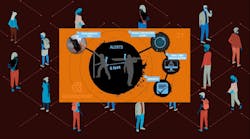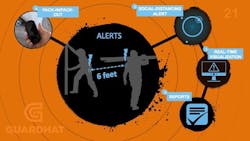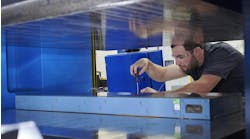As industries reopen, ramp up production or begin a phased return to work, there’s a clear need for innovative tools that will help workers stay safe.
Workplaces are responsible for employee safety during a pandemic. According to the Occupational Safety and Health Administration’s (OSHA), employers are required to furnish to each worker “employment and a place of employment which are free from recognized hazards that are causing or are likely to cause death or serious physical harm to his employees.”
If the goal is to lessen the risk of exposure to COVID-19, employers are on the hook to develop policies and procedures that keep their workplaces free from harm, while employees would do well to work with employers in reinforcing the safety procedures and guidelines. “We have to figure out a way to bring our workers back and provide them an environment that gives them the confidence to come back to work every day,” said Guardhat’s executive vice president of growth, Indranil (Rony) RoyChoudhury. “And in instances where infections happen, we should be able to isolate the individuals, quarantine them or take preventive measures to stem the spread of infection.”
Contact Tracing
Guardhat’s real-time situational awareness systems have undergone only incremental upgrades in keeping with social distancing criteria and are based on CDC guidelines, explained RoyChoudhury.
As part of a contact tracing system, the company’s Atlas tag is essentially a small form factor safety tag, generating both an audible visual and a haptic alert when another tag comes within six feet of its location. Depending on a factory’s available infrastructure, alerts are sent from the device through LTE or Wi-Fi to Guardhat’s data control and analytics engine, known as Kyra. The devices and sensors communicate directly with personnel, as opposed to relaying data to remote servers. RoyChoudhury noted that along with other wearables (such as Guardhat’s RHEA mobile app and smart hard hat), the solution provides additional safety features, such as SOS and emergency evacuation alerts.
Users can run reports and analysis to find out if safety protocols were breached or if an infection was detected. Further preventive action can be taken by identifying how many individuals a person was exposed to at different points in time, as well as the duration of the contact, and ultimately pointing the way to isolating affected individuals or getting them tested, as needed.
Strong Connection
“In industrial plants, where you have tons of steel and other obstacles, connectivity can be extremely spotty—if at all available,” RoyChoudhury explained. To solve this issue plants may create their own network infrastructure using Guardhat’s solution. The devices are intelligent enough to store information and provide real-time social distancing alerts using Bluetooth. Once the user is back in a zone where there is connectivity (e.g., an LTE or Wi-Fi zone), it automatically uploads that data for contact-tracing purposes.
If a company already has an Industrial IoT platform—such as IBM Watson—Guardhat’s device integrates to the existing platform, RoyChoudhury confirmed. Alternatively, third-party devices can be installed to work with Guardhat’s IoT platform.
Data Capture
Data collected can be stored in two ways: on a cloud or on premise. When stored in the cloud, the data is completely encrypted, but if hosted on premise, the plant has its own security infrastructure located on the connected worker platform.
All data collected are owned by the client and are encrypted from a user support perspective. Even when Guardhat provides a helpdesk, the information is completely anonymized, said RoyChoudhury. Care is taken to obfuscate the location and ensure the identity of the user can be selected or triggered.
When using the Atlas tag, an individual’s identity does not appear on the system, and there can be multiple layers of anonymization that can be built in, explained RoyChoudhury. For instance, a geofencing facility creates blackout zones. A restroom is a classic blackout case that will not appear on the grid. “Someone going to the restroom will vanish off the grid, but will retain the ability to send an SMS message in case he or she has an event,” said RoyChoudhury.
Several layers of considerations that require the user’s consent are “baked in.” Some features are not accessible to a user because appropriate controls are created at a systems level and data deletion processes are established from a governance perspective. Examples include customized algorithms created for data protection officer (DPO) role definition, administration of rights of access and the right to be forgotten.
At the end of an employee’s shift, for example, data can be deleted once it is transferred to the main server for contact tracing purposes. Or, if there’s a breach, the geofencing feature is activated around the factory location. “If somebody cuts the tag and steps outside of the factory location, connectivity to the device completely goes out, so the device becomes completely dumb,” RoyChoudhury said.
Privacy Rules
As employers are asked to do their part in stemming the spread of COVID-19, their responsibility will be amplified with the use of employee monitoring systems—an area of controversy before the pandemic. The personal nature of wearable sensors has the potential to expose personnel to a number of vulnerabilities, including invasion of privacy, abuse of data and the likelihood that they might expose private information. Network-connected devices, such as employee tracking devices and medical-grade wearable sensors, pose a risk and require manufacturers to justify their design and process decisions based on risk analyses and validation data, using the U.S. Food and Drug Administration “least burdensome approach.”
Similarly, the Equal Employment Opportunity Commission has expressly reaffirmed its guidance on pandemics as a way to waylay areas of concerns for employers. Taking steps to protect employees and the public data employers need to be cognizant of the specific requirements that affect their workplaces.
Nothing’s Foolproof
For RoyChoudhury, no market solution can guarantee safety. “There are no entities—whether it is Apple or Google—that can provide absolute conviction that a solution is going to prevent infections, or provide complete confidence that nothing is going to happen,” he said. At best, a contact tracing solution is a framework that offers management and workers a level of confidence and enables them to investigate and take precautionary measures, he cautioned.
Guardhat currently holds eight patents across the areas of connected worker, real-time location systems and wearable solutions, making it well-placed as a purveyor of social distancing devices. Still, in the evolving workplace where physical distancing or fixed workplaces are becoming less feasible, sizing up whether the benefits of social distancing devices outweigh the risks rests with each enterprise.
Neither is it Guardhat’s intention to be primarily associated with devices designed for fighting COVID-19, said RoyChoudhury. “I hope this thing goes over very fast,” he reinforced. “Our solution is fundamentally built for industrial safety and productivity. We are simply tweaking it to address the use case that we have right now.”
Back-to-Work Guidance
The following recommended websites provide the most current and accurate occupational health and safety information:



